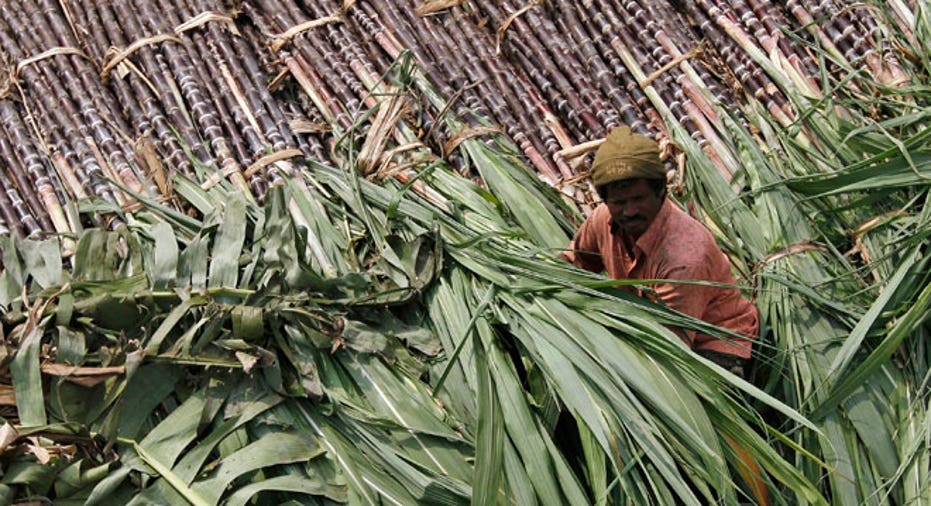Global Sugar Surplus in Jeopardy

The global sugar surplus era is coming to an end.
After three straight years of big surpluses, the sugar market is heading towards a balance or a small deficit next season due to adverse weather in Brazil and Asia, higher-than-expected Chinese demand and steady growth in consumption.
Shifts from surplus to deficit can take several years in the highly cyclical market.
"A lot of the weather problems that we are encountering now are going to have a bigger effect on production next year," Robin Shaw, an analyst at broker Marex Spectron, said.
"With an annual increase in consumption, we're going into a small deficit."
Raw sugar futures on ICE traded near nine-week highs this week at 18.28 cents a lb, supported by worries that El Nino weather could curb output.
The string of surpluses had taken prices from a peak of 36.08 cents in February 2011 to a low of 14.70 cents in January this year.
The International Sugar Organization (ISO) this month said a more balanced sugar market appeared likely in 2014/15 after successively smaller global surpluses in 2012/13 and 2013/14.
"If world production remains stable at the estimated level for this season, the world sugar economy will be in balance," the London-based ISO said in its latest quarterly report.
On the demand side, analysts say Chinese sugar imports have consistently exceeded expectations due to high domestic prices, auguring for further erosion of world surpluses. China is a leading raw sugar importer.
Solid global sugar consumption growth running at some 2.2 to 2.5 percent a year, driven by Asia's fast-growing economies, is contributing to the shift from surplus to a more balanced market.
"Assuming an average growth in global sugar demand at the level of 4 million tonnes (a year), but no considerable increases in the production level, the deficit phase may finally start developing," the ISO said in its report.
WEATHER
On the supply side, a drought in Brazil from November to February has hampered cane plantings, reducing harvest prospects in the world's top sugar producer and exporter.
Furthermore, an increasing likelihood of an El Nino weather pattern is likely to slow harvesting in Brazil later this year and bring unfavorably dry weather to major Asian producers, analysts and traders said.
Marex Spectron's Shaw said El Nino could lead to heavy rains in Brazil around July, hindering cane harvesting.
"Relatively dry weather in Thailand, Australia and Indonesia could mean that farmers will not be able to re-plant as much as they would like," he added.
India, the world's number 2 sugar producer, is set to produce less cane next season due to prospects for a poor monsoon season and because cash-strapped mills are in arrears in payments to cane farmers, analysts say.
"We expect that the volume of cane cut will most likely decline in 2014/15 year-on-year as a result of the arrears situation between growers and millers," said Tracey Allen, commodities analyst with Rabobank International.
"The Indian monsoon will also be an important driver of Indian cane yields, and a drier-than-normal monsoon would drive cane and most likely sugar production lower."
India's monsoon may hit the southern Kerala coast around June 5, the weather office said on Thursday, a delayed onset that raises fears of poor rains in the initial days of a season threatened by El Nino.
Sergey Gudoshnikov, a senior ISO economist, said the extent of the erosion of world sugar surpluses could be linked to expectations over El Nino.
"Weather patterns will have a big effect on the production outlook," he said. "We don't know if it will be a strong El Nino or a weak El Nino. Before we know the strength, it will be difficult to quantify negative effect on global output."
Gudoshnikov said that, despite the shift to a more balanced market, sugar stocks are high. The three years of surpluses amounted to an excess of more than 22 million tonnes of production over consumption.
In October 2014, world stocks could be as high as 80 million tonnes, or more than 45 percent of annual global use of sugar, according to the ISO.
Even though the surplus era is drawing to a close, the big stocks will ensure little risk of any global shortage any time soon.